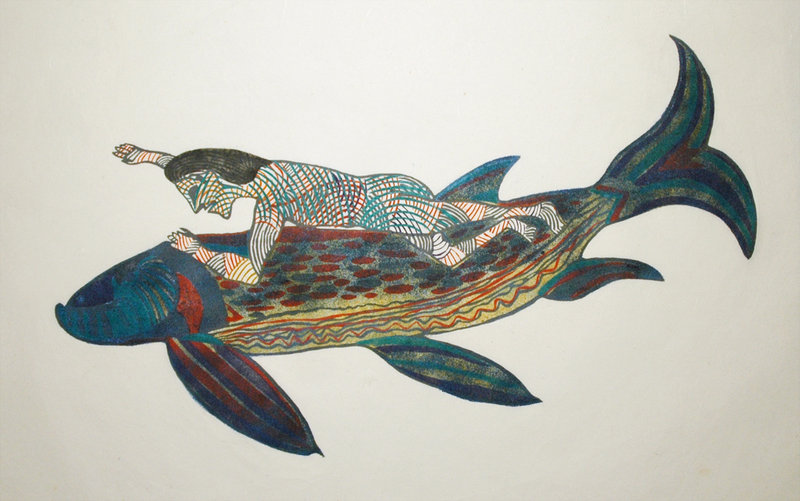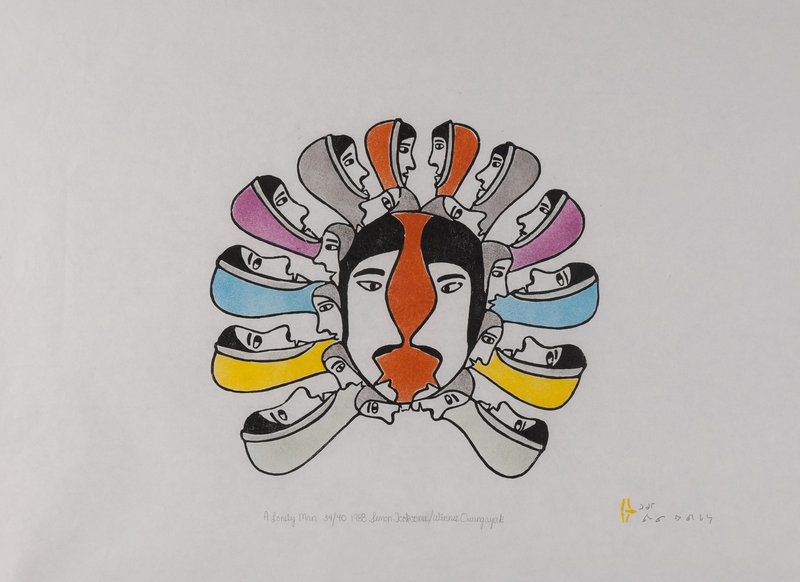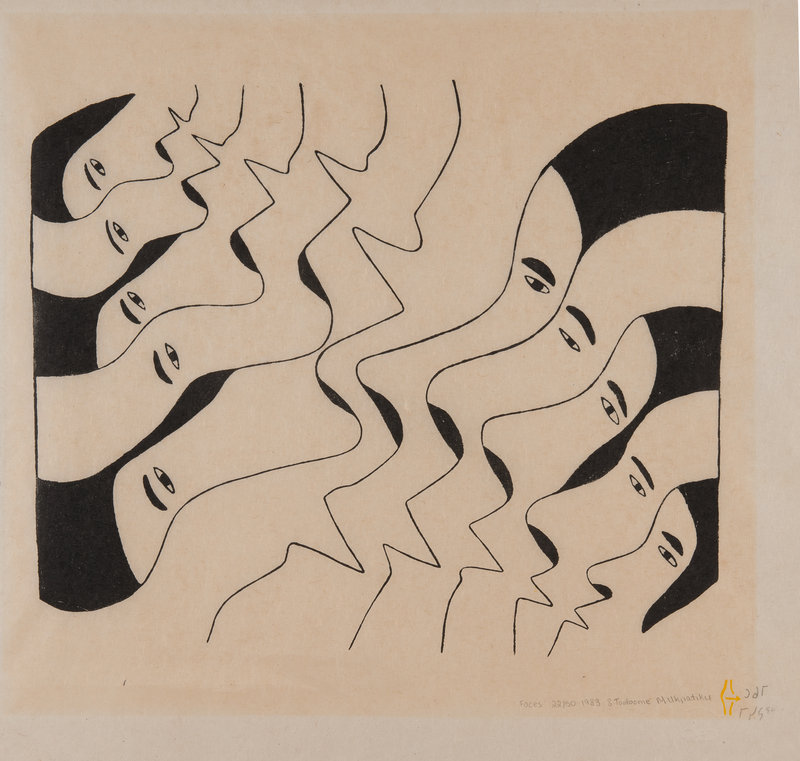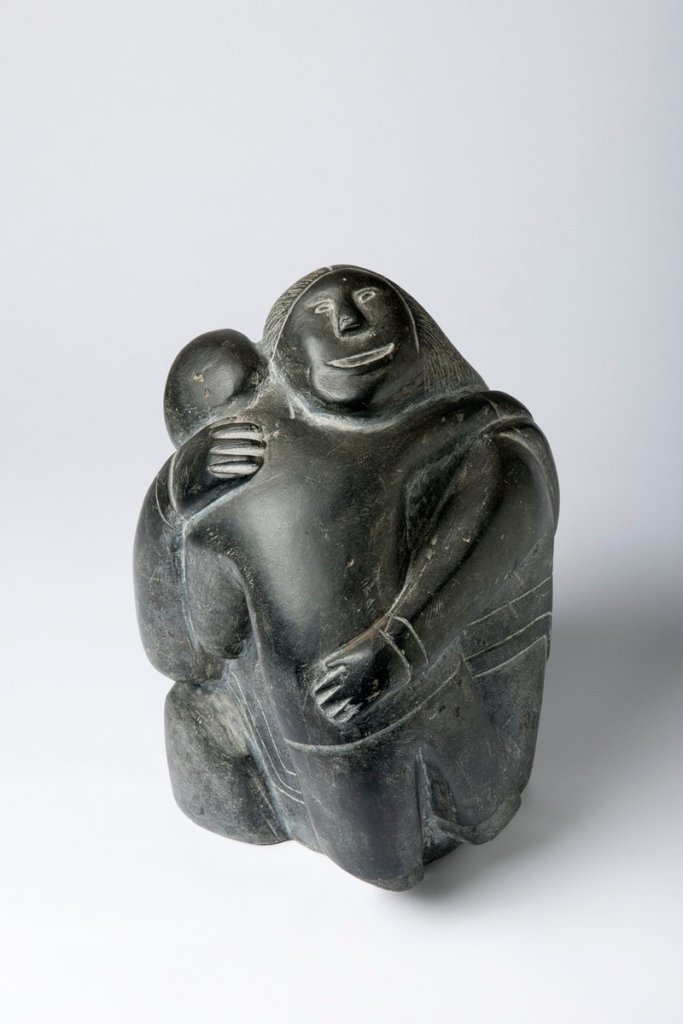BRUNSWICK – A new exhibition at the Peary-MacMillan Arctic Museum suggests the small and sometimes overlooked museum on the Bowdoin College campus may be ahead its time.
Peary-MacMillan just opened a year-long exhibition, “Imagination Takes Shape,” featuring almost 100 prints and carvings by Canadian Inuit artists culled from the collection of Robert and Judith Toll.
Inuit art is fairly hot right now, and this collection includes colorful prints and stone carvings, many of which depict animal legends central to Inuit culture, as well as the importance of family and community bonds. Several well-known contemporary artists are represented, including Padlo Pudlat, Jessie Oonark and Simon Tookoome, who died just before the Bowdoin exhibition opened.
The Tolls, who live in California and otherwise have no ties to Bowdoin, last year pledged their collection of Inuit art, which they have been building during a decades-long love affair with the art and culture of the Canadian Arctic, to the Bowdoin museum. This show represents the first public display of part of the Tolls’ gift.
“They were looking for a home for their collection, and looking for a location where their gift could make a difference,” said museum director Susan Kaplan, who has known the Tolls for 10 years and lobbied hard for the couple to leave their collection with Bowdoin.
The couple wanted a museum that would share the collection in public displays, and also where it could be used in scholarship. Bowdoin offered both, along with the allure and history of the museum itself. Peary-MacMillan is named for Arctic explorers and Bowdoin grads Robert Peary and Donald MacMillan, and is the only museum in the United States dedicated to Arctic studies.
Ultimately, it was the Arctic studies component that sold the Tolls on Bowdoin. “We are excited about the use of the collection in teaching, especially the kinds of in-depth student involvement both the college and Arctic studies encourage,” Robert Toll said in a statement.
The Toll collection gives Bowdoin high-profile status in Inuit art circles. The Winnipeg Art Gallery in Winnipeg, Manitoba, Canada, houses the largest collection of Inuit art, and the Museum of Inuit Art in Toronto opened a few years ago, giving the specialty art form a major footing in the world of contemporary art.
The Bowdoin collection adds to the momentum.
The tradition of Inuit art goes back centuries, although it’s been since the mid-1900s that the commercial component of Inuit art, and thus its collecting legacy, has been promoted. Recognizing the potential economic benefit of promoting the artistic legacy of the isolated communities of the Canadian Arctic, the Canadian government actively encouraged the promotion of Inuit sculpture and culture beginning circa 1950.
The Tolls began collecting in the 1960s, and focused their efforts on specific communities on the western edge of Hudson Bay. “They’ve gone for depth, not for breadth,” Kaplan said, explaining that the Tolls decided it was more important to capture the range of the Inuit experience. Many of the prints in this collection come from two primary printmaking cooperatives — one in Cape Dorset; the other at Baker Lake.
“The Tolls, in their collection, recognized that Inuit life was difficult and full of transition. You get pieces in this collection that reflect some of those themes,” Kaplan said.
Curator Genevieve LeMoine points to several examples. One of the first prints in the exhibition is a 1987 piece by Pudlat, “New Horizons.” The title implies, and the art suggests, a new day for the Inuit as they move away from their traditional lifestyle represented by ox and into a contemporary setting represented by telephone wires.
A print by Oonark speaks to the importance of community. She makes a human face in the middle of her image, then surrounds it with smaller faces that form a circle. The implication is that the individual is surrounded by ancestors, family members, friends and the larger community, and that one’s journey through life is never taken alone.
Part of Oonark’s brilliance is the double meaning of some of her work. In this instance, the print “The People” has larger implications. The faces, as they spiral outward from the center, also form the image of an igloo when viewed from above. Again, the print represents the sense of home, LeMoine said.
Generally, “Imagination Takes Shape” is a colorful show. The stone carvings tend to be bland in color, but the prints are spectacularly colorful.
“That’s typical of the later periods of printmaking represented here,” LeMoine said, pausing by the print “Qiviuq’s Journey” by William Noah, in which a legendary Inuit hero crosses the ocean on a magical flying fish.
“In the early days of printmaking, the artists’ access to color was somewhat limited,” LeMoine said. “As a result, you had a lot of monochromatic prints. But as time went on, their access to materials improved, and the prints became more colorful.”
Similarly, the early prints were generally stonecut or soapstone. In recent generations, the artists have incorporated other techniques, such as silk screening and linocuts, into their work.
The exhibition will remain on display through December 2011. The Tolls, who live in Oakland, Calif., came to Bowdoin for the opening in November.
Kaplan hopes the presence of the Toll collection and the attention it brings the Peary-MacMillan Arctic Museum will foster further debate on campus and throughout the community about the desire for a new facility to house the museum and its collection.
“A gift like this could be inspiration for a new facility,” Kaplan said. “The institution knows we need one. Maybe a gift like this will generate some discussion about that need.”
Staff Writer Bob Keyes can be contacted at 791-6457 or at: bkeyes@pressherald.com
Follow him on Twitter at: twitter.com/pphbkeyes
Send questions/comments to the editors.






